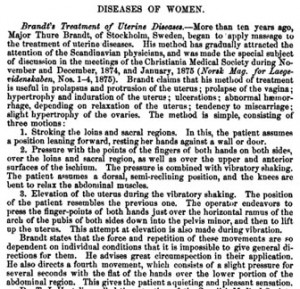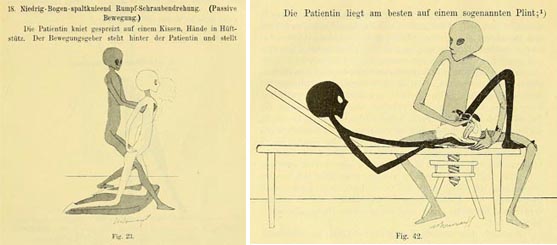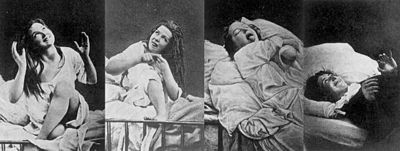Good Vibrations: The Myth of the Victorians and the Vibrator by Dr Kate Lister, Researcher at Leeds Trinity University.
Dr. Kate Lister is a researcher at Leeds Trinity University in historical attitudes to sexuality and sex work. She is the curator of the online project and popular Twitter account @WhoresofYore where she tweets the history of illicit sex and works to promote sex worker rights and challenge stigma to over 82,000 followers. The Whores of Yore project is unique in its aims to create a space for academics, artists, sex workers and activists to collect their research. Kate is on the board of the international sex work research hub, works with local charities who support sex workers in the UK. Kate has published on the history of media narratives around sex work, the history of menstruation and sexual violence in historical dramas.
———————————
I am sure you have heard this one; Victorian doctors invented the vibrator to masturbate women to ‘hysterical paroxysm’ (orgasm) because they had developed repetitive strain injury in their fingers from manually rousing patients to multiple hysterical paroxyms. We love this story. I love this story. Hollywood loved this story so much that the 2011 film Hysteria was based on this story. So it is with a heavy heart that I have to tell you, this really is just a story. But, like all the best stories, there are flashes of truth in it. I will tread lightly and salvage as much as I can because I know how pervasive and popular this myth is. Not only is it much loved, it’s well established and is referenced in numerous texts, documentaries, online sources and has become part of our collective history. We love it because it goes straight to the hysterical heart of the Victorian sexual hypocrisy that we enjoy rolling our eyes at; ‘did you know Victorian doctors were diddling female patients, but considered exposed table legs to be sexually obscene? So glad we’re not like that now!’ (Except the table legs thing is also myth, but that’s another post for another day.)
The root of the vulva massage theory is Rachel Maine’s book, The Technology of Orgasm (1999). Here, Maines hypotheses that doctors masturbated women to orgasm for health reasons, and that the vibrator was nothing short of a ‘God send’ for the physicians suffering from cramp in their index fingers. More than this, Maines makes the case that this practice can be traced back to Classical times. However, it has to be said that her evidence for medical vulva massage in the ancient World has been discredited, most notably by Professor Helen King (2011). It’s also important to remember that Maines herself refers to her argument as a hypothesis; and to be fair, it’s a damn interesting one. In an online interview in 2010, Maine said,
‘People just loved my hypothesis and that’s all it is really, it’s a hypothesis, that women were treated with massage for this disease, hysteria, which has supposedly existed since the time of Hippocrates, 450 B.C., and that the vibrator was invented to treat this disease. Well, people just thought this was such a cool idea that people believe it, that it’s like a fact. And I’m like, ‘It’s a hypothesis! It’s a hypothesis!’. But it doesn’t matter, you know? People like it so much they don’t want to hear any doubts about it’ (Maines, 2011).
So, let’s unpack this hypothesis a little further. Make no mistake, Victorian doctors were obsessed with sex and health, and there were some highly questionable medical theories flying around; from Dr Kellogg’s thoughts that masturbation was terminal, to Italian criminal anthropologist, Cesare Lombroso’s theories that sex workers had no sensation in their clitorises, as they had been rendered ‘insensible’ through ‘overuse’ (Lombroso et al., 2009). But the theory that Doctors invented vibrators to induce orgasm and cure hysteria is doubtful for a number of reasons.

British doctor, Joseph Mortimer Granville, patented the first electrical vibrator in the 1880s, not as a sexual device but as a massager to relief the aches and pains of men – NOT women; he was quite clear on that. His invention was known as the ‘Granville Hammer’ as it was designed to strike to body in a percussive motion. In his book Nerve-Vibration and Excitation as Agents in the Treatment of Functional Disorder and Organic Disease (1883), he wrote, “I have never yet percussed a female patient … I have avoided, and shall continue to avoid the treatment of women by percussion, simply because I do not wish to be hoodwinked, and help to mislead others, by the vagaries of the hysterical state” (Granville, 1883). Furthermore, one look at this contraption and I am sure we can all agree that this electrified hammering device is not something you would want anywhere near your genitals without adult supervision and a safe word. This was clearly not designed for internal use.
Other vibrating massagers soon followed suit on a wave of pseudo-scientific theories about electricity and vibrating massage, which was touted as a cure all panacea, along with rectal dilators and radium. Vibrating massage promised to alleviate all manner of mental and physical disorders (including the mysterious ‘hysteria), but they were not designed for use on the genitals, and, more importantly for this article, they were not used by Doctors to induce orgasm.
An article in the 1871 Good Health journal outlines exactly how the electrical ‘vibrator’ is to be used. ‘The Vibrator is simply a labor-saving machine in the matter of agitating or exercising particular portions of the body.’

And if we are to believe that vibrators were common knowledge and widely used to induce orgasm, we have to account for the fact that there is not one mention of this in any known Victorian pornography (textual or visual). Not one. However, there are many references to dildos, and occasionally the odd cucumber put to good use. Sex toys are not new. The earliest dildo found was excavated in Germany and is over 28,000 years old. The Victorians knew how to design a good sex toy – the design has (unsurprisingly) changed very little in over 28,000 years. It tends to be, well, penis shaped. Victorian dildos were made from wood, leather and even ivory, and they were certainly a lot of fun, as this extract from The Pearl (1880) demonstrates:
“As we are five to two you will find I have a stock of fine, soft, firmly made dildoes to make up the deficiency in males, which alternated with the real article will enable us to thoroughly enjoy ourselves” (The Pearl, 1879).
Then, there was this jolly song published in Choyce Drollery: Songs and Sonnets (1876) that opens with,
With a dildo, dildo, dildo,
With a dildo, dildo, dee,
Some say ’twas a man, but it was a woman
As plain report may see.
She first climb’d up the Ladder
For to deceive men’s hopes,
And with a long thing in her hand
She tickled it on the ropes

Not only is there no known mention of Doctors and vibrators in Victorian pornography, there is also no mention of it in the work of the early and pioneering sexologists. Iwan Bloch, Havelock Ellis, Richard von Kraft-Ebing and Freud meticulously catalogued every fetish, paraphilia and known expression of sexual behaviour, but not one of them mention doctors, vibrators and orgasm. Ellis and Bloch even describe some women deriving sexual pleasure from sewing machines and beetroot, but there is no mention of a vibrator. Fifty years later, in his seminal Behaviour in the Human Female (1953), Alfred Kinsey does not mention vibrators in his lengthy and comprehensive chapters on female masturbation.
But, what about medical texts themselves? Surely there must be some mention of doctors conducting ‘pelvic massage’ or the ‘hysterical paroxysm’? Well, yes! Yes, there is and lots of it. The medical craze for pelvic massage came from the work of Swedish obstetrician and gynaecologist, Thure Brandt Brandt (1819-1895), who began treating women in 1861. The ‘Thure Brandt method’ of pelvic massage and ‘manipulating the womb’ proved very popular. The International Record of Medicine and General Practice Clinics (1876) described the technique in some detail.

As you can see, the technique is performed outside the body and with a noticeable lack of a vibrator or an orgasm. “Vibrating” is part of the massage, but it means vigorously shaking the patient whilst applying pressure to the pelvic area with the hands. In 1895, Brandt published The physiotherapy in gynaecology and the mechanical treatment of diseases of the uterus and its appendages by Thure Brandt, which contains possibly the most terrifying illustrations of gynaecological techniques ever produced in the history of humanity.
Once you have moved past the fact that the doctor and patient strongly resemble escapees from Area 51, you will notice that the technique is about applying pressure to the pelvic area in a variety of odd positions. We can also see that some of the massage was internal (this was a gynaecological procedure after all!), and involved inserting a finger and applying the other hand on the abdomen and pushing downwards. But, at no point is an orgasm, sexual arousal, or a vibrator required. Brandt published this work almost fifteen years after Granville had patented his “hammer”, and there were numerous vibrating massagers available, and yet they do not feature in technique. The theories behind ‘pelvic massage’, and the techniques employed are frankly bizarre, but it should not strike us as odd that gynaecologists would perform internal examinations; doctors carried them out then, just as they do now. When a medical text is describing pelvic massage – it means massage of the pelvic area (and maybe the odd finger.) However, it seems that it is here, in the confusing practice of pelvic massage and fancy fingering, that the myth about doctors collectively draining the national grid as they buzzed their patients into post orgasmic delirium, developed.
The other persistent part of the medical vibrator story is that of “hysterical paroxysm”; which Maines understands as being ‘the female orgasm under clinical conditions’ (Maines, 1999). But, when we start to investigate the medical texts of the era, a hysterical paroxysm doesn’t sound like any orgasm I’ve ever had. Hysterical and Nervous Affections of Women: Read before the Harveian Society describes a hysterical paroxysm as ‘an uncontrollable attack of alternate sobbing and laughter’ (Anderson, 1853). Andrew Whyte Barclay’s A Manual of Medical Diagnosis (1862), describes it as a ‘fit’ and ‘a simulation of epilepsy’ (Barclay, 1862). John Henry Walsh describes the hysterical paroxysm as beginning with uncontrollable giggling, and lasting ‘for at least an hour, and often for five or six’ (Walsh, 1858); and Dr Henry Beasley noted that ‘flatulent distension of the bowels’ often precedes an attack of hysterical paroxysm (Beasley, 1855). Medical theories of the time do link this strange phenomenon to a gynaecological issue. Walsh wrote that a ‘copious secretion of pale urine accompanies the disease’ (Walsh, 1858). George Bacon Wood wrote that hysterical paroxysm was ‘apt to be worse around the menstrual period’ (Wood, 1852); and James Copland lists menstruation, amenorrhea and ‘morbid conditions of the ovaries’ as leading causes of the hysterical paroxysm (Copland, 1860). But, this should not be surprising as the word ‘hysteria’ comes from Latin hystericus, meaning “of the womb”; and from the Greek hysterikos, meaning ‘suffering in the womb’.

However, one defines hysteria, by the mid nineteenth century, it had reached near epidemic proportions and its links with the womb and menstruation were well known. Dr. John Burns in his The Principles of Midwifery (1811) wrote that menstruation is ‘to be considered as a disease’ (Burns, 1811). It was not only a disease but a dangerous one which, if not controlled properly, could lead to madness. The theory of uterine madness held a tight grip on the understanding of even the most prominent of nineteenth century physicians. Dr. William Rowley, professor of medicine at Oxford University and member of the Royal College of Physicians, eagerly wrote of the ‘passio hysterica’ repressed menstruation, or amenorrhea, could bring about in women; ‘The tongue falters, trembles, and incoherent things are spoken; the voice changes; some roar, scream or shriek immoderately; others sigh deeply, weep or moan plaintively’ (Rowley, 1800). Dr. Althaus agreed and wrote that ‘hysterical attacks almost always occur after a sudden suppression of the menstrual flow’ in 1848 (Althaus. 1848). It is significant to note that menstrual madness is frequently understood to be violent and the sufferer liable to commit criminal acts of savagery. Dr Jacobi feared that during the time of menstruation women were prone to some very disturbing behaviour, ‘At such times a woman is undoubtedly more prone than men to commit any unusual or outrageous acts’ in 1868.
A hysterical paroxysm was simply another ill-defined category of hysteria, linked to the womb, that can be found in nineteenth-century medical manuals; along with the hysterical coma, hysterical headaches, hysterical excitement, hysterical convulsive affections, and (of course) hysterical flatulence.
But more than this, the Victorians knew what an orgasm was! There was no need to dress it up in euphemistic language. Even a cursory glance at the erotic literature of the time will tell you, the Victorians knew what an orgasm was. ‘I felt her crack deluged with a warm, creamy spend whilst my own juice spurted over her hand and dress in loving sympathy’ (The Pearl, 1879). ‘She came again three times in the next six nights; each time we renewed our mutual joys, with ever increasing voluptuous indulgencies’ (Romance of Lust, 1873). “How many times I made her spend it would be impossible to say’ (Saul, 1881). As Fern Riddell, one of the leading academics in Victorian sexuality, argues ‘Victorian doctors knew exactly what the female orgasm was; in fact, it’s one of the reasons they thought masturbation was a bad idea’ (Riddell, 2014).
Not only did Victorian doctors know what an orgasm was, but nineteenth-century medical theories taught that orgasms were potentially dangerous and needed to be limited. Masturbation in women was thought to cause hysteria, not cure it. In The Generative System and Its Functions in Health and Disease (1883), James George Beaney claimed that a disease ‘associated with, and very often closely depending on, female masturbation is hysteria’ (Beaney, 1883). Gunning S. Bedford wrote that ‘excessive sexual excitement, masturbation, etc., are all so many causes capable of giving rise to this nervous disturbance’ (Bedford, 1869). In 1852, Samuel La’mert drew a clear distinction between hysterical paroxysm and masturbation when he wrote ‘females devoted to libidinous and solitary pollutions, are more particularly exposed to hysterical paroxysm’ (La’mert, 1852). In 1894, Dr A.J. Bloch of New Orleans referred to female masturbation as a “moral leprosy.” So dangerous was female masturbation thought to be, that it was cited on numerous patient admission forms to Victorian lunatic asylums. Dr Issac Brown famously pioneered clitoridectomies as a cure for female masturbation. He was widely criticized at the time, but he was allowed to continue and publish his findings in esteemed medical journals. Sparse diets were recommended to subdue lust, and purity crusaders, such as John Harvey Kellogg (1852-1943), manufactured plain cereals to suppress urges. Kellogg argued that masturbation could cause “cancer of the womb, urinary diseases, nocturnal emissions, impotence, epilepsy, insanity, and mental and physical debility’. If women were habitual masturbators, Kellogg recommended burning out the clitoris with carbolic acid as an ‘excellent means of allaying the abnormal excitement, and preventing the recurrence of the practice (Kellogg, 1888).
Now, I ask you, does this sound like a group of people likely to prescribe masturbation?
So, what can we salvage from this much loved and widespread myth? Well, we can take some comfort that there are nuggets of truth here. It is true that Victorian doctors were fascinated with the female reproductive system, and, like their medical predecessors, linked madness to the womb. In an attempt to cure hysteria, in all its weird manifestations, they prescribed all manner of kinky sounding treatments; including pelvic massage. They also had some very strange ideas about orgasm and masturbation damaging health and causing hysteria. There was also such a thing as a ‘hysterical paroxysm’, which is described as some kind of giggly, gassy meltdown that can last for hours. It’s also true that vibrating massagers became popular in the late nineteenth century.
But, here is the crucial thing; Victorian doctors may have been manipulating, sedating, institutionalising and pummelling the pussies of their poor farting female patients – but they were not masturbating them to ‘hysterical paroxysm’ with electrical vibrators.
Sorry to be such a buzzkill.
© Dr Kate Lister
Note: Photograph of stone phallus: A 7.8-inch (20cm) long, 1.1-inch (3cm) wide stone object (pictured) was found in the Hohle Fels Cave near Ulm in the Swabian Jura. The prehistoric ‘tool’ is made from 14 fragments of siltstone and dates back 28,000 years. Due to its size, experts believe it may be the earliest example of a sex aid ever found


